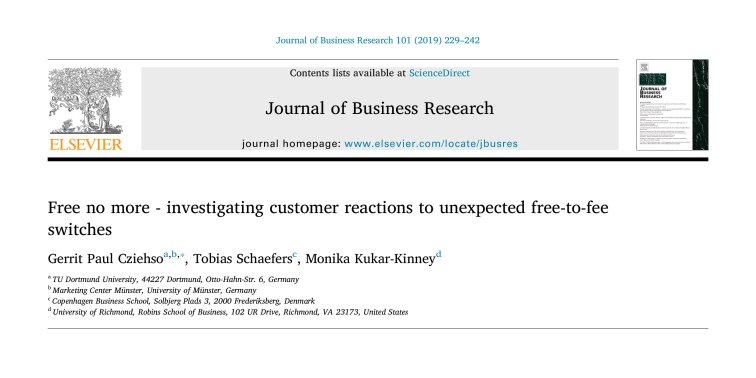Free No More! Research by Gerrit Cziehso about Price Introductions Published in JBR

Dr. Gerrit Cziehso recently published a study on customer's reactions to unexpected price introductions in the Journal of Business Research (Vol. 101). Unexpected price introductions occur when companies introduce prices for previously free products or services. These strategic decisions are common in many industries, such as hospitality (e.g., introduction of fees for internet access inside the hotel), banking (e.g., introduction of checking account fees), or media and entertainment (e.g., introduction of fees for using online content). However, companies often struggle with customer churn after their price introduction.
In cooperation with Professors Tobias Schaefers (Associate Professor of Marketing at Copenhagen Business School, Denmark) and Monika Kukar-Kinney (Professor of Marketing and Robins School of Business, University of Richmond, USA), Gerrit Cziehso conducted three empirical studies to compare and investigate customer's reactions to different ways of unexpected price introductions. In particular, Dr. Cziehso and his colleagues compared a forced (hard) price introduction, in which continued service usage is only possible if the requested fee is paid, to a (soft) freemium switch, which additionally entails the option to continue using a service with reduced features for free.
The team analyzed different samples (i.e., students, general population) and experimental designs (i.e., repeated measures, cross-sectional data) to show that there is a goal conflict between minimizing customers negative perceptions and maximizing purchase intentions for the fee-based service. The results reveal that compared to a forced switch, a freemium option leads to higher fairness perceptions and attitudes but lower purchase intentions, as the additional free-version cannibalizes demand for the commercial product. “The study shows that the best course of action depends on what the company’s primary goals are. If the firm’s key intention is to boost purchase intentions for the fee-based service, then a forced switch is recommended. If the firm wants to build long-term customer relationships, a freemium model might be the better option”, Dr. Cziehso explains.
If a company decides to introduce a price by using a freemium switch, the question of what service features should be offered for free arises. Dr. Cziehso and his colleagues answer this question with their research findings: “Our empirical results show that a free version with high features leads to lower purchases of the commercial product because it is too similar to the original version. For us, however, it was a big surprise that substantially reducing the free version’s features can also backfire, as customers perceive that kind of offer as unfair and hence react with lower purchasing intentions. In our studies, we found that companies should offer a medium level of features in the free version and also obtain customer's feedback to determine the appropriate level of feature pruning in a freemium situation”, Dr. Cziehso concluded.
A copy of the study “Free no more - investigating customer reactions to unexpected free-to-fee switches“ can be obtained here.

